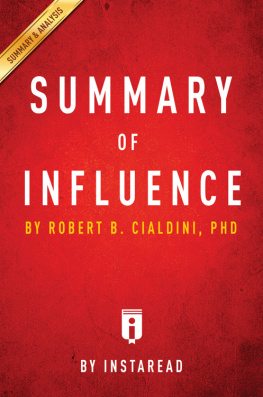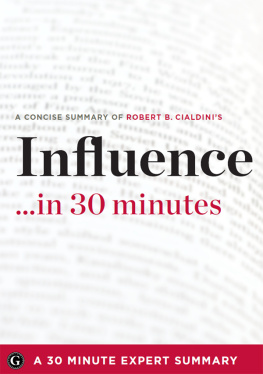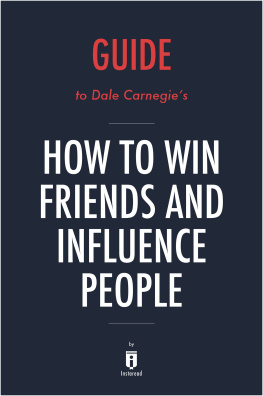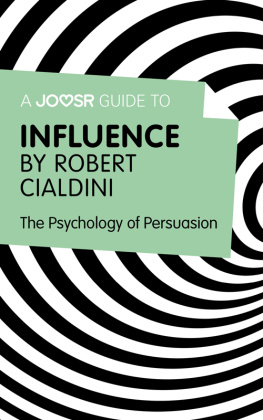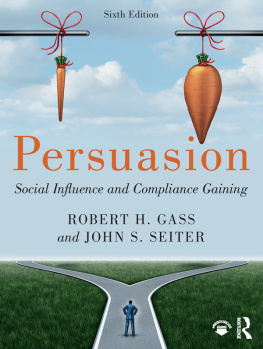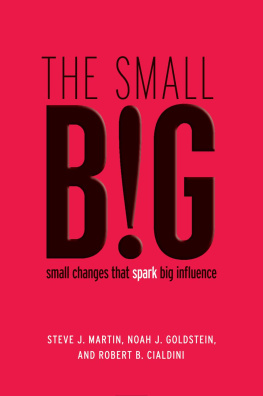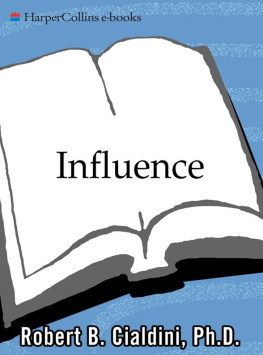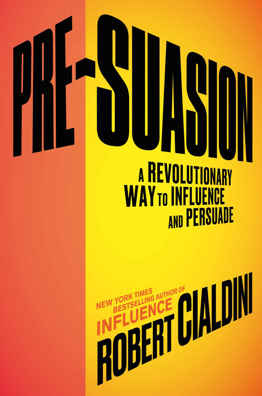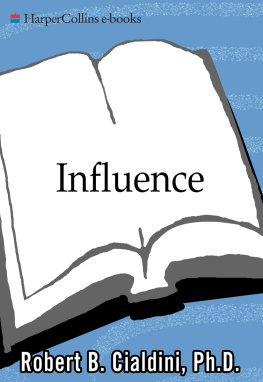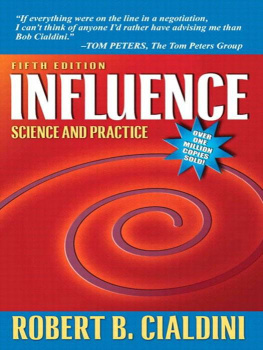Summary of
Influence
The Psychology of Persuasion, Revised Edition
by Robert B. Cialdini, PhD

By Instaread

Please Note
This is a summary with analysis.
Copyright 2016 by Instaread. All rights reserved worldwide. No part of this publication may be reproduced or transmitted in any form without the prior written consent of the publisher.
Limit of Liability/Disclaimer of Warranty: The publisher and author make no representations or warranties with respect to the accuracy or completeness of these contents and disclaim all warranties such as warranties of fitness for a particular purpose. The author or publisher is not liable for any damages whatsoever. The fact that an individual or organization is referred to in this document as a citation or source of information does not imply that the author or publisher endorses the information that the individual or organization provided. This concise summary is unofficial and is not authorized, approved, licensed, or endorsed by the original books author or publisher.
Table of Contents
Overview
Robert B. Cialdinis Influence: The Psychology of Persuasion examines the compliance methods by which marketers, salespeople, and others, such as cult leaders, pressure people into doing things they would not otherwise do. There are six basic compliance tools: reciprocity, consistency, social proof, liking, authority, and scarcity. Readers can learn specific techniques to resist each.
Humans rely on standard responses in many situations. For example, when one person gives another a gift, the recipient automatically feels indebted and is inclined to reciprocate. These mental shortcuts are usually helpful both to the individual and to society as a whole. Reciprocity helps facilitate mutual aid, which in turn helps solidify social bonds. These bonds in turn strengthen both the group and the individuals within it.
However, these automatic social responses can be used by salespeople, or compliance professionals, to make people buy things, or do things, that are not in their self-interest. A salesperson may give customers a free sample. Even though the customers do not want the sample, once they have taken it, they will feel indebted to the giver, and will be more inclined to buy a product as a way to reciprocate.
Understanding methods of compliance can help individuals to resist them. If people know about reciprocity, they can refuse the initial gift, or take it recognizing it is not actually a gift, and so not feel bound by reciprocity. Knowledge can prevent people from buying things they dont want, or from being conned.
Learning about compliance techniques is also important, however, because the misuse of those techniques endangers society. People need mental shortcuts to navigate an increasingly complex world and culture. Compliance professionals exploit and therefore undermine those shortcuts. By taking advantage of the desire for reciprocity, for example, they make people distrust reciprocity. Compliance professionals take advantage of trust between people, and make it difficult for people to rely on others, or even on their own intuitions or evaluations of their own needs and desires. Exposing compliance methods is therefore vital not just to help individuals avoid scams, but to ensure the health of society as a whole.
Important People
Robert B. Cialdini is professor emeritus of psychology and marketing at Arizona State University. He has written a number of books on business and marketing. Influence: The Psychology of Persuasion, first published in 1984 and revised in 2006, is by far his most well-known work.
Stanley Milgram (1933-1984) was a social psychologist known for controversial experiments on obedience and authority.
Key Takeaways
- People have fixed-action triggers; they act in certain ways when confronted with certain situations. Compliance professionals use these triggers to convince people to do things they otherwise would not do.
- People have a trigger for reciprocity. If someone gives a person a gift, the recipient feels indebted and wants to give a gift in return.
- People have a trigger for self-consistency. They want to make their actions conform to their earlier actions or words.
- People are susceptible to social proof. They want to do what everyone else is doing.
- People have a trigger for likability. They are inclined to trust and to be influenced by people they find likable.
- People will obey authority figures.
- When an item is scarce, people will find that item more attractive. This is because losses are experienced more intensely than gains.
- By understanding how influence works, people can resist it.

We hope you are enjoying this Instaread ebook
Download the Instaread app to get unlimited text & audio summaries of bestselling books.
CLICK HERE TO LEARN MORE
Analysis
Key Takeaway 1
People have fixed-action triggers; they act in certain ways when confronted with certain situations. Compliance professionals use these triggers to convince people to do things they otherwise would not do.
Analysis
When a male robin sees another male robin enter his territory, the first robin will be triggered to attack. This is generally a useful behavior. However, when scientists show the robin a bundle of red feathers, it will also attack. The trigger, which works well under most circumstances, can also be used to confuse and manipulate the robin.
What is true of the robin is also true of humans. People react automatically to some triggers. For instance, people are more likely to grant a request if they are given a reason for doing so. Normally, checking for reasons is a good way to evaluate whether a request is sensible. But this fixed-action trigger can also be used to deceive. Researchers have found that people are more likely to comply with any given reason, even one that makes no sense or adds no information.
For instance, at the grocery store, people are more willing to agree if someone says, Can I cut in line because I need to buy groceries? than if someone says, Can I cut in line? The trigger word because can be used by unscrupulous salespeople to fool individuals, just as the red feathers were used to fool the robin.
There are many cases in which humans exhibit instinctual fixed-action patterns exactly like those observed in other animals. Newborn babies will grasp objects placed in front of them, for example, and will especially grasp hair. This may be because baby primates in humans ancestral past would hold on to their mothers body hair while being carried. [1]
Key Takeaway 2
People have a trigger for reciprocity. If someone gives a person a gift, the recipient feels indebted and wants to give a gift in return.
Analysis
Cross-cultural studies have shown that gift giving and reciprocity are embedded in virtually all human cultures. When people receive a gift, they feel indebted to the giver. This is the case even if the gift was not requested and is not wanted.
The principle of reciprocity can be a powerful tool of influence. For instance, members of the Hare Krishna religion used to ask for donations in airports. They discovered that giving people flowers first, and then asking for donations, increased giving substantially. This was the case even when people did not want the flowers, and threw them away immediately.
Next page
